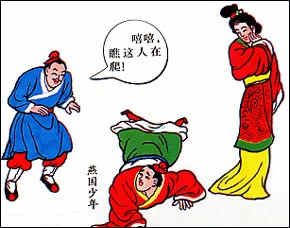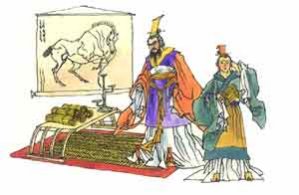
-----readed_count
-----Update_order
닷컴고사 Mobile Menu, Mobile Idioms, Cyber World Tour, 숫자로 배우는 사자성어 1(일一, 일壹) 2(이二, 이貳) 3(삼三, 삼參) 4(사四) 5(오五) 6(육六) 7(칠七) 8(팔八) 9(구九) 10(십十) 100(백百) 1,000(천千) 10,000(만萬), 이담속찬(耳談續纂), 중급사자성어2000개, 한국역사부도, 세계역사부도, 역사년표
고사성어 동의어/유사어/반의어 백과사전 테마별 고사성어
 ,
고사성어 150문제, 속담격언 120 문제, 사자성어 포함 한문문제를 연달아...
김삿갓漢詩,
생활속의 고사성어 (2018
,
고사성어 150문제, 속담격언 120 문제, 사자성어 포함 한문문제를 연달아...
김삿갓漢詩,
생활속의 고사성어 (2018 , 2017, 2016, 2015년, 2014년, 2013년, 2012년, 2011년, 2010년, 2009년, 2008년, 2007년, 2006년, 2005년, 2004년, 2003년),
신규등록 고사성어 , 최신시사 사자성어NEWS
, 2017, 2016, 2015년, 2014년, 2013년, 2012년, 2011년, 2010년, 2009년, 2008년, 2007년, 2006년, 2005년, 2004년, 2003년),
신규등록 고사성어 , 최신시사 사자성어NEWS ,
열국지, 초한지, 中國.五大奇書, 삼국지관련
고사성어, 블로그, 成语낭독,
,
열국지, 초한지, 中國.五大奇書, 삼국지관련
고사성어, 블로그, 成语낭독, 
어떤 고사성어에 대한 이야기일까요? 맞추어 보세요.
▶ Looking for a Steed with the Aid Of Its Picture
During the Spring and Autumn Period, there was a man in the State of Qin whose name was Sun Yang. Sun Yang was very expert in looking at horses and judging their worth. Whatever the horse might be, he could tell whether it was good or bad at first sight. People called him Bo Le (Bo Le was the name of one of the celestial bodies and was fabled to be in charge of heavenly steeds), and he was often asked to appraise and select horses.
One day, when Sun Yang was passing a place, an old horse pulling acart loaded with salt suddenly neighed to him without stopping. He came near, and saw that it was a horse that really could cover a thousand Li a day, and that the only problem with it was that it was a little too old. The old horse was pulling the heavy cart with difficulties and hardships. Sun Yang felt acutely that the horse was really unjustly treated, for it might have been a fine steed galloping on the battlefield. It was a great pity that it was pulling the cart loaded with salt without attracting public attention, which had taken the edge off its spirit and consumed its energy. When he thought of this, he was so grieved that he shed tears.
In order to help more people learn how to appraise horses so that fine horses which could cover a thousand LI a day would no longer fall into oblivion, and also in order to ensure that his unique skill in judging horses would not be lost, Sun Yang worte a book entitled The Art of Looking at Horses and Judging Their Worth, based on his experiences and knowledge accumulated over the years. The book was also illustrated with the pictures of various horses.
Sun Yang had a son who, after reading his father's The Art of Looking at Horses and Judging Their Worth, thought it was very esay to appraise horses. So he took the book with him to look for fine horses everywhere. At first he searched according to the pictures in the book, and accomplished nothing. Then he searched according to the characteristics of a toad fit very well the characteristics described in the book. So he happily took the toad back home, and said to his father, "Father, I have found a horse that can cover a thousand Li a day, only its hoofs are not good enough." Looking at the toad, Sun Yang did not know whether he should laugh or cry. Knowing that his son was stupid, Sun Yang said humourously. "It's a pity that this horse is too fond of jumping to pull a cart." Then he sighed, "That is just what we call looking for a steed with the aid of its picture."
Later, people have used the set phrase "look for a steed with the aid of its picture" to refer to handling affairs mechanically in the outmoded ways without being flexible. Somethimes it is also used to refer to trying to locate something by following up a clue. This set phrase originates in Lumbering in the Forest of Art written by Yang Shen in the Ming Dynasty (1368-1644).
【유사어】照本宣科、生搬硬套

▶ 春秋时,秦国有个名叫孙阳的人,善于鉴别马的好坏,他把自己识马的经验写成书,名为《相马经》。这本书图文并茂地介绍了各类好马,所以人们把孙阳叫“伯乐”。
书上写着:良马有高高的额头,鼓起的眼睛,马蹄是圆圆的。孙阳的儿子熟读了这本书后,以为自己学到了父亲的本领,便拿着《相马经》去找好马。一天,他在路便看见一只癞蛤蟆,前额和《相马经》上好马的特征相符,就以为找到了一匹千里马,马上跑去告诉父亲:“和你书上画的好马差不多,只是蹄子不像。”孙阳听后,哭笑不得,开玩笑地说:“这匹马太喜欢跳了,不好驾驭。” 这个成语比喻机械地照书本上的知识,不求事物的本质。
▶ 春秋时候,秦国有个叫孙阳的人,擅长相马,无论什么样的马,他一眼就能分出优劣。他常常被人请去识马、选马,人们都称他为伯乐(“伯乐”本是天上的星名,据说负责管理天马)。
有一次,孙阳路过一个地方,忽见一匹拖着盐车的老马冲他叫个不停,走近一看,原来是匹千里马,只是年龄稍大了点。老马拉着车艰难地走着,孙阳觉得太委屈了这匹千里马,它本是可以奔跑于疆场,可以发挥更大作用的宝马良驹,现在却默默无闻地拖着盐车,慢慢地消耗着它的锐气和体力,实在可惜!孙阳想到这里,难过得落下泪来。
为了让更多的人学会相马,使千里马不再被埋没,也为了自己一身绝技不至于失传,孙阳把自己多年积累的相马经验和知识写成了一本书,配上各种马的形态图,书名叫《相马经》。
孙阳有个儿子,看了父亲写的《相马经》,以为相马很容易,就拿着这本书到处找好马。他按照书上所绘的图形去找,一无所获。又按书中所写的特征去找,最后发现有一只癞蛤蟆很像书中写的千里马的特征,便高兴地把癞蛤蟆带回家,对父亲说:“爸爸,我找到一匹千里马,只是蹄子稍差些。”父亲一看,哭笑不得,没想到儿子竟如此愚笨,便幽默地说:“可惜这马太喜欢跳了,不能用来拉车。”接着感叹道:“所谓按图索骥也。”
故事出自明朝杨慎的《艺林伐山》。成语“按图索骥”,比喻机械地照老办法办事,不知变通;也比喻按照某种线索去寻找事物。
【翻译】Looking for a Steed with the Aid Of Its Picture.
【释义】索:寻找,骥:好马。按照画像去寻求好马,比喻按照线索寻找,或办事机械, 死板。
【例句】我们要学习外国的先进经验,但不可按图索骥地搬用,那样自然会得不偿失。
【近义词】照本宣科、生搬硬套
【反义词】不落窠臼
한국 Korea Tour in Subkorea.com Road, Islands, Mountains, Tour Place, Beach, Festival, University, Golf Course, Stadium, History Place, Natural Monument, Paintings, Pottery, K-jokes, UNESCO Heritage, 중국 China Tour in Subkorea.com History, Idioms, UNESCO Heritage, Tour Place, Baduk, Golf Course, Stadium, University, J-Cartoons, 일본 Japan Tour in Subkorea.com Tour Place, Baduk, Golf Course, Stadium, University, History, Idioms, UNESCO Heritage, E-jokes, 인도 India Tour in Subkorea.com
 History,
UNESCO Heritage, Tour Place,
Golf Course,
Stadium,
University, Paintings,
History,
UNESCO Heritage, Tour Place,
Golf Course,
Stadium,
University, Paintings,
|
|||||||||||||||||||||||||||||||||||||||||||||||||||||||||||||||||||||||||||||||||||||||||||||||||||||||||||||||||||||||||||||||||||||||||||||||||||||||||||||||||||||||||||||||||||||||||||||||||||||||||||||||||||||||||||||||||||||||||||||||||||||||||||||||||||||||||||||||||||||||||||||||||||||||||||||||||||||||||||||||||||||||||||||||||||||||||||||||||||||||||||||||||||||||||||||||||||||||||||||||||||||||||||||||||||||||||||||||||||||||||||||||||||||||||||||||||||||||||||||||||||||||||||||||||||||||||||||||||||||||||||||||||||||||||||||||||||||||||||||||||||||||||||||||||||||||||||
12간지(生肖成语) : 쥐Rat鼠, 소Ox牛, 호랑이Tiger虎, 토끼Rabbit兎, 용Dragon龍, 룡Dragon龍, 뱀Snake蛇, 말Horse馬, 양Sheep羊, 원숭이Monkey猴, 닭Chicken鶏, 개Dog1狗, 개Dog2犬, 돼지Pig猪, 동물 : 여우fox狐, 코끼리Elephant象, 이리Wolf1狼, 이리Wolf2狼, 곰Bear熊, 고양이Cat猫, 사슴Deer鹿, 물고기Fish魚, 표범Leopard豹, 당나귀Donkey驴, 까마귀Crow烏, 학Crane鶴, 사마귀mantis螳螂, 식물(植物) : 꽃Flower, 풀Grass, 나무Tree1, 나무Tree2, 열매Fruit, 4계절(四季) : 봄Spring, 여름Summer, 가을Autumm, 겨울Winter, 방향(方位) : 북North, 동East, 서West, 남South, Anim


































